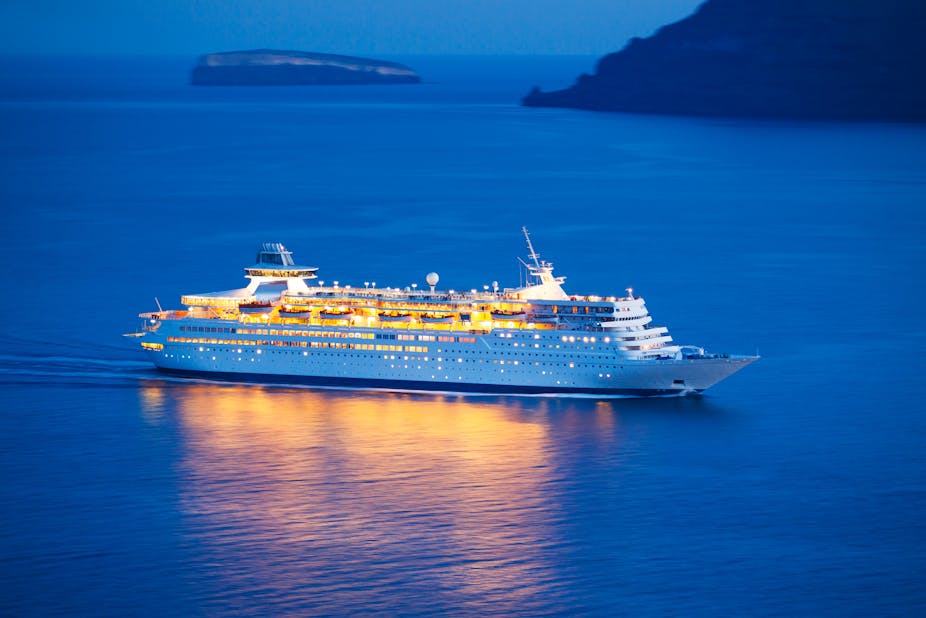In January and February 2014, two major earthquakes hit the Greek island of Kefalonia. No one was killed and only one person injured, thanks to strict construction rules in an area of regular seismic activity, yet the earthquakes were a human disaster nonetheless: they damaged the homes of about 5,000 of the 36,000 island inhabitants, leaving them all homeless.
Large scale homelessness and damaged infrastructure are common after earthquakes like these. After this Kefalonian disaster, however, something unique happened: luxury cruise ships provided victims with temporary accommodation and other necessities in the days and weeks that followed.
This has the potential to be tremendously important to how we handle disasters in future. It could provide a blueprint that has major implications both for victims and economic recovery.

To avoid the worst when crises like earthquakes strike, governments and NGOs continuously prepare disaster relief plans. There include three internationally recognised phases. There’s a preparation phase, which is about logistics: sourcing everything from emergency services to food to tents. These resources are then deployed during phase two, immediate response, ahead of a third phase for reconstruction.
In Kefalonia, the island’s authorities did not have the resources to handle these phases in-house. Amid heavy rain and cold weather in the hours after the first earthquake struck, they requested assistance from NGOs like the Red Cross and Lions Clubs and, unusually, the private sector – in this case Greek shipowners. These organisations all began collaborating instantly.

Some victims received standard-issue army tents and camped in a local sports stadium for a night, which is the sort of thing that traditionally happens in these situations. But temperatures were very cold and there was no heating, so they were taken along with everyone else to two cruise ships. These had been provided by the shipowners either free or at minimum cost within 24 hours of the first earthquake.
Making a difference
Victims and other local people that participated in our research into how the disaster was handled said that using these vessels brought only positive outcomes. The crew’s training in handling demanding customers during regular cruises was extremely useful, since many victims were severely traumatised.
The ships gave these people high-quality accommodation, catering and sanitary facilities, which enabled them to think about how to restructure their lives in a safe and relaxed environment. Our respondents all agreed it was a much better solution than camping. Many victims remained onboard for two months.
The other benefit of moving the victims offshore was that it cleared the vicinity of the earthquake. This made it easier for the local government to focus on quickly repairing damaged infrastructure such as roads, water supply systems and ports. It enabled it to skip much of the first two phases in dealing with a natural disaster and move straight to reconstruction.
It is worth pointing out that the shipowners did not get involved for any potential future economic benefit. They sought no publicity and were ready to break ongoing contracts if necessary to assist the victims. Like the crew and everyone else involved in the humanitarian response, they were motivated purely out of a sense of doing the right thing.

Shipping them in
According to the UN Environment Programme, half of the world’s population lives within 60km of the sea, and three-quarters of all large cities are located on the coast. What happened in Kefalonia should therefore be seen as a template for disaster relief for a large proportion of the world’s population.
Cruise ships can provide an immediate high-quality response that is not affected by weather conditions. While they would have been less helpful after the recent earthquake in Accumoli in Italy, which was further inland, Kefalonia demonstrates how such ships can free up resources for restoration.
Neither is there any need to ask shipowners for favours in the event of disaster. Country governments in high-risk zones ought to be assessing to what extent their shipping sector might be able to help, and open negotiations in advance. Countries without shipping industries ought to be looking at reaching agreements with shipowners from other countries, while NGOs should consider their potential to help with such arrangements, too.
In Greece two years ago, necessity was the mother of an extremely innovative invention. Not only could it benefit other countries after natural disasters, there is no reason why it couldn’t be used to handle other situations of human distress such as refugee crises as well.

